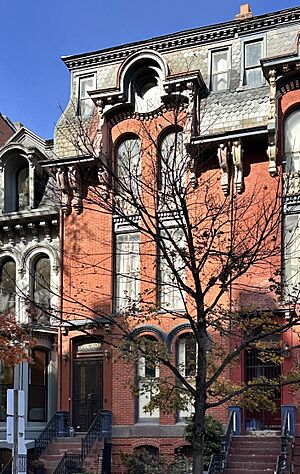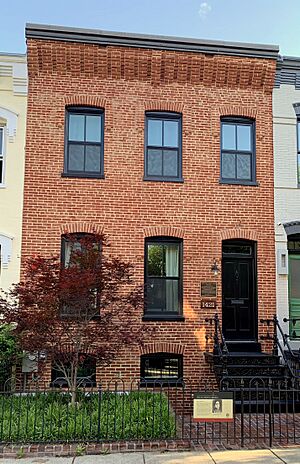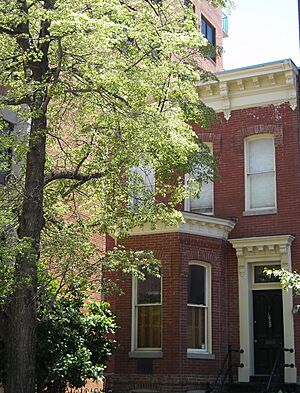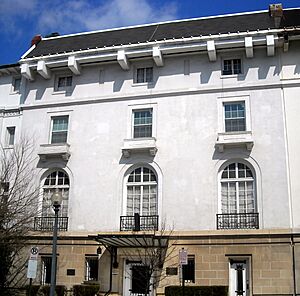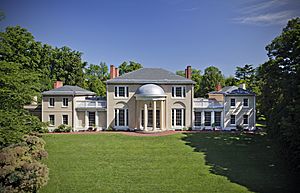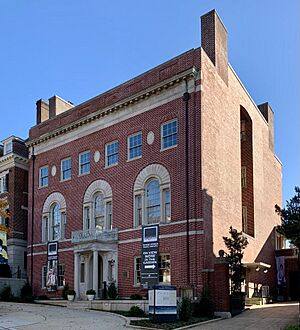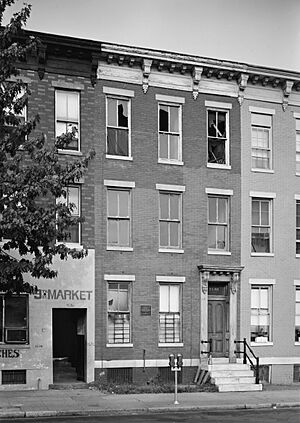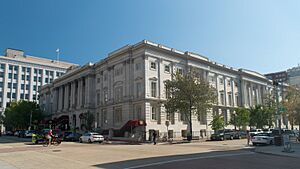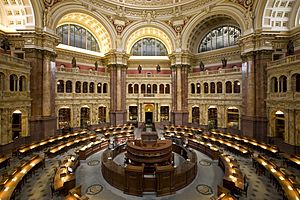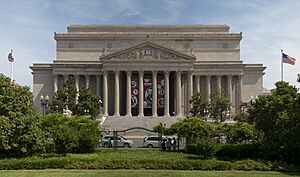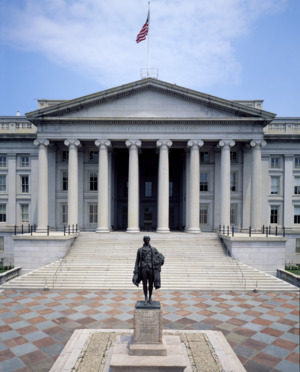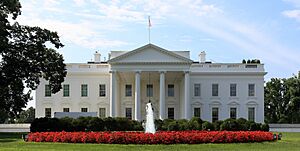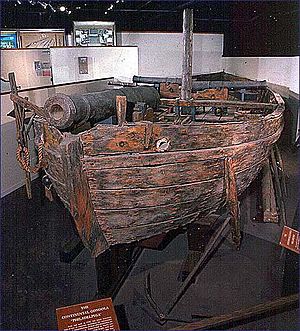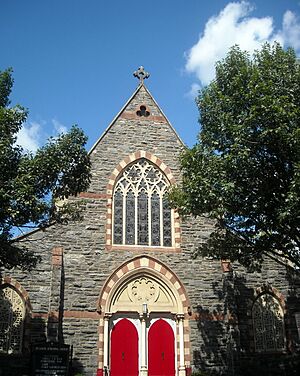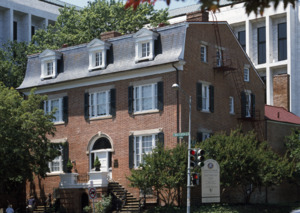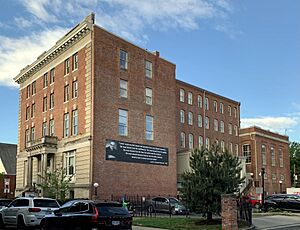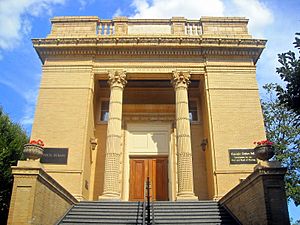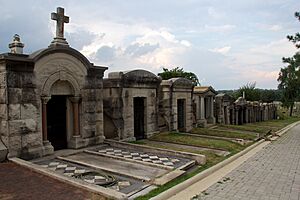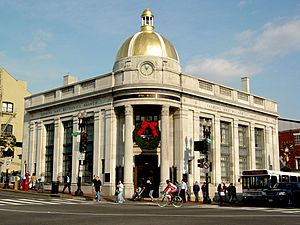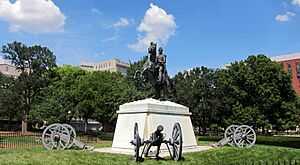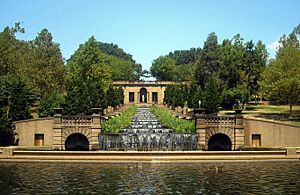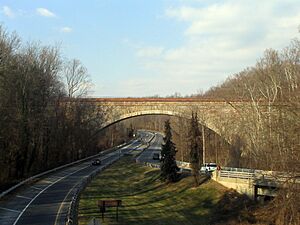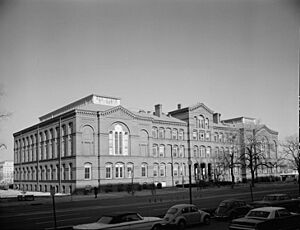List of National Historic Landmarks in Washington, D.C. facts for kids
The District of Columbia, which is the capital city of the United States, has 76 special places called National Historic Landmarks. These landmarks are chosen by the National Park Service because they are very important to the history of the country.
These special places in Washington, D.C., show how important the city is as the nation's capital. They include big government buildings, homes where important politicians lived, military bases, and museums. The list also includes places that helped people with disabilities, played a role in the Civil Rights Movement, or show amazing early urban infrastructure (like city planning and buildings).
Most National Historic Landmarks are also listed on the National Register of Historic Places. However, in Washington, D.C., there are three very important exceptions: the White House, the United States Capitol, and the United States Supreme Court Building. These three are definitely landmarks, but they are not on the National Register.
Contents
- Exploring Washington D.C.'s Historic Landmarks
- Homes of Famous Americans
- Cleveland Abbe House: Home of the Weather Man
- Blanche K. Bruce House: A Senator's Home
- Mary Ann Shadd Cary House: A Writer's Legacy
- Elliott Coues House: Bird Expert's Residence
- Decatur House: A Naval Hero's Mansion
- Samuel Gompers House: Labor Leader's Home
- Charlotte Forten Grimké House: An Abolitionist's Dwelling
- Charles Evans Hughes House: A Supreme Court Justice's Home
- Frances Perkins House: First Woman in the Cabinet
- Mary Church Terrell House: A Pioneer's Residence
- Tudor Place: A Link to George Washington
- Woodrow Wilson House: A President's Last Home
- Carter G. Woodson Home: Father of Black History
- Important Government and Public Buildings
- District of Columbia City Hall: The Old Courthouse
- General Post Office: A Beautiful Design
- Library of Congress: A Treasure of Books
- National Archives Building: Keeping Our History Safe
- National War College: Roosevelt Hall
- Old Patent Office Building: Now Art Museums
- Pension Building: National Building Museum
- United States Capitol: Where Laws Are Made
- Treasury Building: Managing the Nation's Money
- White House: Home of the President
- Sites of Social and Cultural Importance
- Gallaudet College Historic District: For the Deaf Community
- USS Philadelphia (1776): A Revolutionary War Gunboat
- St. Elizabeths Hospital: A Historic Mental Health Facility
- St. Luke's Episcopal Church: First African-American Episcopal Church
- Sewall–Belmont House and Museum: Women's Suffrage History
- John Philip Sousa Junior High School: A Civil Rights Milestone
- Twelfth Street YMCA Building: For African Americans
- Volta Laboratory and Bureau: Helping the Deaf
- Other Notable Landmarks
- Homes of Famous Americans
- Moved Landmarks
- See also
Exploring Washington D.C.'s Historic Landmarks
Washington, D.C., is full of amazing historic places! Let's take a closer look at some of these National Historic Landmarks and what makes them special.
Homes of Famous Americans
Many historic homes in D.C. belonged to people who made a big difference in American history.
Cleveland Abbe House: Home of the Weather Man
The Cleveland Abbe House was home to Cleveland Abbe, who is known as the "father of the National Weather Service". He lived here from 1877 to 1909. Before him, even President James Monroe lived in this house! It was built around 1802-1805 and is a great example of the Federal style of homes.
Blanche K. Bruce House: A Senator's Home
The Blanche K. Bruce House was a home of Blanche K. Bruce. He was an African American Senator from Mississippi. His home became a landmark in 1975.
Mary Ann Shadd Cary House: A Writer's Legacy
The Mary Ann Shadd Cary House was home to Mary Ann Shadd Cary, a famous writer and abolitionist (someone who worked to end slavery). This house became a landmark in 1976.
Elliott Coues House: Bird Expert's Residence
Elliott Coues House was where Elliott Coues lived from 1887 until he passed away in 1899. He was a leading expert on birds in the 1800s. He greatly expanded our knowledge of North American bird life and even helped start the American Ornithologists' Union in 1883.
The Decatur House was designed by Benjamin Henry Latrobe for naval hero Stephen Decatur. It's right across from the White House. From 1827 to 1833, it was also home to Secretaries of State like Henry Clay and Martin Van Buren.
Samuel Gompers House: Labor Leader's Home
The Samuel Gompers House was the home of Samuel Gompers, who was the president of the American Federation of Labor (AFL) from 1886 until he passed away in 1924. He helped create the AFL and worked hard to get higher wages, shorter hours, and better working conditions for American workers. He lived in this three-story brick rowhouse from 1902 to 1917.
Charlotte Forten Grimké House: An Abolitionist's Dwelling
The Charlotte Forten Grimké House was a home of Charlotte Forten Grimke, a very important abolitionist and educator. It became a landmark in 1976.
Charles Evans Hughes House: A Supreme Court Justice's Home
The Charles Evans Hughes House was the home of Charles Evans Hughes from 1930 until he passed away in 1948. He was a leader in the progressive movement and even ran for president in 1916. He also served as an Associate Justice and Chief Justice of the United States.
Frances Perkins House: First Woman in the Cabinet
The Frances Perkins House was a home of Frances Perkins, who was the Secretary of Labor. She was the first woman to be part of the United States Cabinet! This house became a landmark in 1992.
Mary Church Terrell House: A Pioneer's Residence
The Mary Church Terrell House was a home of Mary Church Terrell. She was an abolitionist and the first African-American woman to serve on a school board. Her home became a landmark in 1975.
Tudor Place: A Link to George Washington
Tudor Place is a home designed by Dr. William Thornton, who also designed the Capitol building. It holds a collection of items that belonged to George Washington and Martha Washington. It became a landmark in 1960.
Woodrow Wilson House: A President's Last Home
The Woodrow Wilson House (Washington, D.C.) was the home of Woodrow Wilson, who was the 28th President of the United States. He lived here after his presidency. It became a landmark in 1964.
Carter G. Woodson Home: Father of Black History
The Carter G. Woodson Home National Historic Site was a home of Carter G. Woodson, who is known as the "Father of Black History". This important home became a landmark in 1976.
Important Government and Public Buildings
D.C. is also home to many significant government buildings and public spaces.
District of Columbia City Hall: The Old Courthouse
The District of Columbia City Hall, also known as the Old Courthouse, was renovated and reopened in 2009 as the District of Columbia Court of Appeals. It's a very old building, designated a landmark in 1960.
General Post Office: A Beautiful Design
The General Post Office (Washington, D.C.) is a great example of Neoclassical design. It was built in stages between 1839 and 1866 and has beautiful details. It became a landmark in 1971.
Library of Congress: A Treasure of Books
The Thomas Jefferson Building is part of the Library of Congress. It's a massive and beautiful building that holds millions of books, recordings, photographs, maps, and manuscripts. It was designated a landmark in 1965.
National Archives Building: Keeping Our History Safe
The National Archives Building is where important historical documents of the United States are kept, like the Declaration of Independence and the Constitution. It became a landmark in 2023.
National War College: Roosevelt Hall
The Roosevelt Hall (National War College) houses the National War College. This building became a landmark in 1972.
Old Patent Office Building: Now Art Museums
The Old Patent Office Building is now home to the National Portrait Gallery and the Smithsonian American Art Museum. It was designated a landmark in 1965.
Pension Building: National Building Museum
The National Building Museum is housed in the historic Pension Building. This building became a landmark in 1985.
United States Capitol: Where Laws Are Made
The United States Capitol is where the U.S. Congress meets to make laws for the country. It's one of the most famous buildings in D.C. and was designated a landmark in 1960.
Treasury Building: Managing the Nation's Money
The Treasury Building (Washington, D.C.) is where the United States Department of the Treasury is located. This department manages the government's money. It became a landmark in 1971.
White House: Home of the President
The White House is the official residence and workplace of the President of the United States. It's one of the most recognized buildings in the world and has been a landmark since 1960.
Sites of Social and Cultural Importance
Some landmarks are important because of their role in social change or cultural development.
Gallaudet College Historic District: For the Deaf Community
The Gallaudet College Historic District is home to the world's first college for the education of people who are deaf or hard of hearing. It became a landmark in 1965.
USS Philadelphia (1776): A Revolutionary War Gunboat
The USS Philadelphia (1776) is the only remaining American gunboat from the Revolutionary War. It sank during a battle in 1776 on Lake Champlain. It was found in great condition in 1935 and is now at the National Museum of American History.
St. Elizabeths Hospital: A Historic Mental Health Facility
St. Elizabeths Hospital is a very old and important hospital that cared for people with mental health conditions. It became a landmark in 1990.
St. Luke's Episcopal Church: First African-American Episcopal Church
St. Luke's Episcopal Church (Washington, D.C.) was the first African-American Episcopal church in Washington, D.C. It became a landmark in 1976.
Sewall–Belmont House and Museum: Women's Suffrage History
The Sewall–Belmont House and Museum was the headquarters of the National Women's Party. It's also home to a museum about the Suffrage movement, which fought for women's right to vote. It became a landmark in 1974.
John Philip Sousa Junior High School: A Civil Rights Milestone
In 1950, eleven black students were not allowed into the new all-white John Philip Sousa Junior High School. This led to the important 1954 Supreme Court decision in Bolling v. Sharpe. This ruling made segregated public schools illegal in D.C. It was a huge step forward for the modern Civil Rights Movement.
Twelfth Street YMCA Building: For African Americans
The Twelfth Street YMCA Building was the very first "Y" (YMCA) built specifically for African Americans. It became a landmark in 1994.
Volta Laboratory and Bureau: Helping the Deaf
The Volta Laboratory and Bureau was started in 1887 by Alexander Graham Bell to help spread knowledge about people who are Deaf. Today, it's part of the Alexander Graham Bell Association for the Deaf and Hard of Hearing. It became a landmark in 1972.
Other Notable Landmarks
Congressional Cemetery: Resting Place of Leaders
The Congressional Cemetery is where many early D.C. residents and members of Congress who passed away while in office are buried. It became a landmark in 2011.
Georgetown Historic District: A Charming Neighborhood
The Georgetown Historic District is a famous and historic neighborhood in D.C. It was designated a landmark district in 1967.
Lafayette Square Historic District: Near the White House
The Lafayette Square Historic District (Washington, D.C.) includes LaFayette Square Park and the buildings around it, but not the White House itself. It's a very important historic area.
Meridian Hill Park: A Beautiful Urban Oasis
Meridian Hill Park is a beautiful park in D.C. known for its Italian-renaissance style. It became a landmark in 1994.
Washington Aqueduct: Providing Water to the City
The Washington Aqueduct is a system that brings water to Washington, D.C. It even extends into Maryland. It was designated a landmark in 1973.
Moved Landmarks
Sometimes, a landmark might be moved from its original location. In Washington, D.C., there are no landmarks that have been removed from the list. However, some ships that were once landmarks here have been moved to other places. Also, the collection from the Army Medical Museum and Library has been moved to Maryland.
* This museum's collection and library are now part of the National Museum of Health and Medicine in Silver Spring, Maryland. The original building was taken down in 1969.
*
See also
- National Register of Historic Places listings in Washington, D.C.
- List of U.S. National Historic Landmarks by state
- District of Columbia Inventory of Historic Sites
- Historic preservation
- National Register of Historic Places
- History of Washington, D.C.
- Timeline of Washington, D.C.



